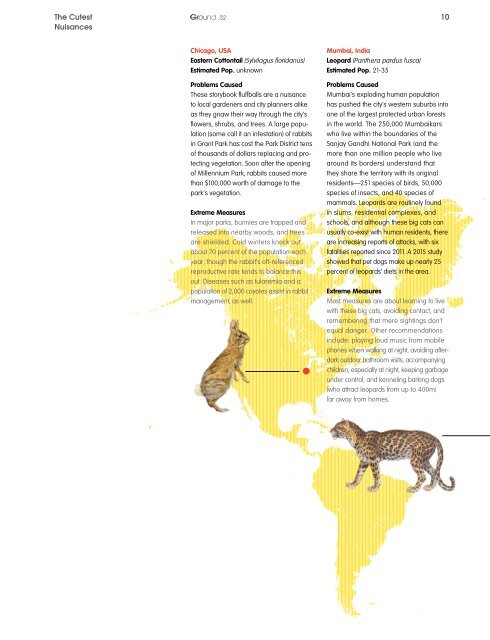You also want an ePaper? Increase the reach of your titles
YUMPU automatically turns print PDFs into web optimized ePapers that Google loves.
The Cutest<br />
Nuisances<br />
.<strong>32</strong><br />
10<br />
Chicago, USA<br />
Eastern Cottontail (Sylvilagus floridanus)<br />
Estimated Pop. unknown<br />
Problems Caused<br />
These storybook fluffballs are a nuisance<br />
to local gardeners and city planners alike<br />
as they gnaw their way through the city’s<br />
flowers, shrubs, and trees. A large population<br />
(some call it an infestation) of rabbits<br />
in Grant Park has cost the Park District tens<br />
of thousands of dollars replacing and protecting<br />
vegetation. Soon after the opening<br />
of Millennium Park, rabbits caused more<br />
than $100,000 worth of damage to the<br />
park’s vegetation.<br />
Extreme Measures<br />
In major parks, bunnies are trapped and<br />
released into nearby woods, and trees<br />
are shielded. Cold winters knock out<br />
about 70 percent of the population each<br />
year, though the rabbit’s oft-referenced<br />
reproductive rate tends to balance this<br />
out. Diseases such as tularemia and a<br />
population of 2,000 coyotes assist in rabbit<br />
management, as well.<br />
Mumbai, India<br />
Leopard (Panthera pardus fusca)<br />
Estimated Pop. 21-35<br />
Problems Caused<br />
Mumbai’s exploding human population<br />
has pushed the city’s western suburbs into<br />
one of the largest protected urban forests<br />
in the world. The 250,000 Mumbaikars<br />
who live within the boundaries of the<br />
Sanjay Gandhi National Park (and the<br />
more than one million people who live<br />
around its borders) understand that<br />
they share the territory with its original<br />
residents—251 species of birds, 50,000<br />
species of insects, and 40 species of<br />
mammals. Leopards are routinely found<br />
in slums, residential complexes, and<br />
schools, and although these big cats can<br />
usually co-exist with human residents, there<br />
are increasing reports of attacks, with six<br />
fatalities reported since 2011. A 2015 study<br />
showed that pet dogs make up nearly 25<br />
percent of leopards’ diets in the area.<br />
Extreme Measures<br />
Most measures are about learning to live<br />
with these big cats, avoiding contact, and<br />
remembering that mere sightings don’t<br />
equal danger. Other recommendations<br />
include: playing loud music from mobile<br />
phones when walking at night, avoiding afterdark<br />
outdoor bathroom visits, accompanying<br />
children, especially at night, keeping garbage<br />
under control, and kenneling barking dogs<br />
(who attract leopards from up to 400m)<br />
far away from homes.


